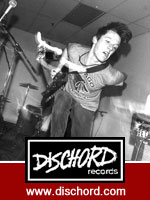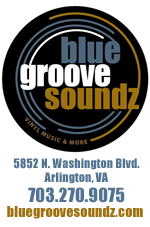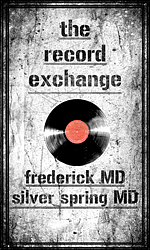
Beginning in the late 1970s, The Cramps developed a large cult fan base in Washington, DC for a variety of reasons: our proximity to NYC, true champions in the music press (Joe Sasfy, Howard Wuelfing), regular college radio play at WGTB and WMUC, simpatico bands to play with (Slickee Boys, Tex Rubinowitz), but most notably, a series of unforgettable performances at the LBJ Club, Psyche Delly, Ontario Theater, and the Hall of Nations at Georgetown University. The Cramps became one of our own, and to this day are credited with altering the musical paths of many lives, including yours truly. (Outrageous Music Festival at Warner Theater in May 1979, Root Boy Slim didn’t have a chance).
The Cramps also launched concert promotion company I.M.P. as the first headliner they ever booked on May 29, 1980. Unfortunately, the band never showed up (and you can read about it here under “What happened when Sam gave up the Ontario?”) But 37 years ago today they did make it back, on a four band show that included Teen Idles, soon to spawn Minor Threat.
Another local who had the Cramps change his life is Steve Blickenstaff of Frederick, MD, the artist behind one of the most iconic album covers ever, The Cramps’ compilation Bad Music for Bad People released in 1984. And his story takes place at the hallowed ground known as 930 F Street. Here’s the story, in Steve’s own words.
So you’re Cramps fan from Frederick, MD?
Exactly. I grew up here. I remember the first album that was released was actually the Gravest Hits which wasn’t even a full album, it was sort of like an EP. That was the first thing that was released on IRS Records and as soon as I heard that I was immediately a fan.
Were you always a cartoonist?
Ever since I can remember I was always drawing cartoons and monsters and different kinds of illustrations, and pretty much out of high school I started doing stuff for fanzines—not really comic books, but t-shirt designs for bands, local friends’ bands, and things like that. And I kind of got more and more into it as time went on.
I still work for the school system in Frederick as a graphic designer, but I do a lot of freelance art on the side, so I do a lot of stuff for bands and things like that these days.
You were a fan of the Cramps and you started bringing them artwork when they would appear in DC?
Right, in fact, any time I saw them even outside of the city. I saw them in Pittsburgh, I’ve seen them in different places, but I would always give them artwork at every show.
When did you see them first?
First time I saw them was at the Ontario Theater in Washington, DC. In fact, the first time I bought tickets for them, the show got cancelled because it was when Bryan Gregory left the band and then they had to reschedule. So I caught them the very next time when they came through.
It would have been very early ‘80s—it could have been 1980, 1981. The Slickee Boys opened for them because I remember the poster.
There’d be five, six, maybe more of us who would go down from Frederick to see them. By the time I gave them the artwork that they used for the Bad Music cover, they were already familiar with me. They knew me by name and we would talk at every show. And the great thing about the 9:30 Club was that you could kind of just walk down the stairs, knock on the door, and pretty much every time you would do that either the band would open the door to see who it was or somebody working for the band—you know, like people traveling with them. I would say, “Hi, I’m so and so and I have some artwork for the band.” I don’t think I was ever turned away. I always kind of got through to the band, and bands were always eager to see what their fans were bringing them.

So, talk a little bit more about that illustration that you did?
I had done drawings for them before in pencil I remember—this was probably the first pen and ink piece. I actually took a lot longer on that one than I had in previous. I guess it was at that point I felt like I knew them and they knew me and I wanted to give them something I thought they would appreciate.
And I knew Lux was specifically into a lot of the old horror comics that I grew up collecting and stuff. So I tried to give the drawing that kind of feel, and he picked right up on it you know, he said, “This is like a Basil Wolverton illustration—he’s one of my favorite artists.” So it was great he recognized that too. I remember Ivy commenting on the wrinkles in the forehead that I had drawn.
How big was artwork?
It was probably, maybe 10″ x 10″ or 12″ x 12″—something like that. And the funny thing is, when I drew that piece, I remember I got snowed in somewhere, and I couldn’t get back to Frederick, and I was worried I wouldn’t be able to—and I think the drawing wasn’t absolutely finished. I needed to finish some tiny little details on it—and I knew the Cramps show was coming up and I didn’t know if I’d get back to Frederick in time to finish up the drawing before the show.
So, while I was stuck at this other house in this big snowstorm, I drew the artwork that was used for the back cover, so I actually gave them both pieces of artwork at that show at the 9:30 Club—that’s why they used the big piece on the front and then—it looks like a pile of zombies faces—they used that on the back cover. So I actually gave them both pieces at that one show. And I had no clue whatsoever that they would decide to use the artwork for a record cover. I just wanted to give them a couple of pieces of artwork.

Did you have a correspondence with them or did you just see them at shows?
Pretty much just at the shows, although I do remember calling and talking on the phone a couple of times, just briefly. I don’t even remember what I would have talked about—it was so many years ago, back in the ‘80s.
I remember one of the shows that we went to in Pittsburgh…after the show we were talking to them and they were asking where we were staying and we told them and Lux said “Oh, that’s the same hotel where we were staying.” So after we got back to the room, a little while later we got a phone call in the hotel room and it was Lux and he said, “Hey, is it ok if I stop by for a few minutes?” and we said absolutely.
So, he came over and he was in his pajamas and he gave me this really really cool gift—it was a towel, like a hotel towel that Ivy had taken—I forget which album which she wore this black fringe outfit on the cover—and then she also wore it in the concert—and she washed it in the sink after the show and laid it out on the towel. When she picked it up I guess the black ink, the dye from the material, made a pattern on the top and bottom like a two piece—it made the impression on the towel. So she had signed the towel and they gave me that as a gift. I still have that. I thought that was really cool.
Do you remember the date that show was? In DC?
I know it was in November 1983. I could probably check on the internet for the exact date. (Consider it done—it was Tuesday, November 1, 1983. —Ed.)
What was it like hearing from the record company? How did that transpire?
Well, what happened was one day I got a call, it was somebody from IRS Records. I have no idea who it was, but it was somebody who said they had just gotten out of a business meeting with Lux and Ivy and they had given him a couple of pieces of artwork and they wanted to use it for the album cover of the new release that was coming out, and at the time I thought maybe it was like a new album of new material. But as it turned out, I guess it was basically an album that was put out to fulfill their contract with IRS because they had broken off with them and this was going to be their last release with them. It was kind of like a “best of” album.
In fact, I think I asked the guy what the name of the album was going to be, and at the time he told me it was going to be called “Wanted Dead or Alive,” and I thought, “Oh ok, that would work really well with that illustration.” It’s almost like, you know, one of those old portraits that they would hang up “Wanted Dead or Alive” and this is what the guy looks like, you know. But then when it came out I realized they had changed the title to Bad Music for Bad People.
How long after you gave it to them did you hear from them?
It was probably a month later because the record came out in April of ‘84, so it must have all happened pretty quickly. It would have been a period of just several months.

What was that like for you to see it?
Oh, it was unbelievable. They sent me a promo, a printed copy of the album cover unfolded first which I still have—that’s really cool. It felt like I was dreaming, because to me it was just a drawing that I had sat at a table and drawn.
You know it’s funny, it kind of has taken on a life of its own. When I see it now, to me it looks like a very familiar image, but it’s funny to think back that I actually drew that myself because it has been printed all over the place. It’s been in movies and here, there, and everywhere.
What was your relationship with Lux and Ivy after that?
Very friendly people, very nice any time I saw them—they just were very welcoming. In fact I remember talking to Ivy at a show at the Warner Theater and she asked if IRS had taken care of me with the album cover art—and I said I’m not sure I understand what you mean. And she said “Well, didn’t they pay you for it?” And I said no, no they never sent me any money, and they acted like, “Oh that’s terrible—they definitely should have.” She said, “Do you want me to write you a check—how much would you like?” And I said, “Oh no, that’s fine. Having my work on your album cover is like a dream come true.”
That’s great—that’s quite an honor as a fan—a humble genuine effort.
Oh yeah, I’m just such a huge fan. To me it’s like, I can’t believe I don’t have to pay YOU to put my artwork on your cover. I would pay YOU to do it.
That’s wonderful. Are you credited?
Oh yeah, all over it. In fact my name appears on the front and the back of the record cover, so it’s definitely everywhere. You know it’s funny, all the people who bootleg my shirt, they always take my name off I don’t know why. I’m not sure what the reasoning is behind that. Some of them leave it on, but most remove my name.
So it’s on T-shirts—it’s everywhere?
I’ve seen sculptures of it. I mean I own a belt buckle, a lapel pin…they use it on mouse pads. Recently I’ve seen it as cell phone covers. Pretty much anything you can think of, I think I’ve seen it in one form or another.
People probably have all sorts of misconceptions about it.
I’ve encountered several people in Cramps Facebook fan pages who are under the impression that the Cramps didn’t approve of my artwork being used on the cover of their album. I’ve even seen people make false statements about Lux and Ivy despising the artwork. That’s very frustrating for me.
Well, I’m happy to help set the record straight—and I just love the fact that it ties in with DC and the old 9:30 Club.
I used to love going to the 9:30 Club. We used to go at least once a month. I used to be in a band and we even played there twice. I was in a band called The Skeptics. One time we opened for Half Japanese and another time we opened for Love Tractor.
I have the original photo stats of the artwork too, which is just as sharp as the original. But I wish I could find the original, preliminary sketches…
 9:30 Club entrance, Atlantic Building, 930 F Street, NW, Washington, DC, Summer 1990 Photo: John McWilliams for Historic American Buildings Survery (Library of Congress)
9:30 Club entrance, Atlantic Building, 930 F Street, NW, Washington, DC, Summer 1990 Photo: John McWilliams for Historic American Buildings Survery (Library of Congress)

Stephen Blickenstaff continues to draw and paint in Frederick, MD, and can be found on Instagram and Facebook. He’s available for commissions too. You can also find him behind a theremin with Atomic Mosquitoes.
Jeff Krulik is a filmmaker, archivist, and historic footage researcher in Silver Spring, MD. His films include Heavy Metal Parking Lot, Led Zeppelin Played Here, and the upcoming Tales of Belair in Bowie.
















